The Efficacy and Safety of Laparoscopy for Blunt Abdominal Trauma: A Systematic Review and Meta-Analysis
Abstract
1. Introduction
2. Materials and Methods
2.1. Published Study Search and Selection Criteria
2.2. Data Extraction
2.3. Quality Assessment
2.4. Statistical Analysis
3. Results
3.1. Selection and Characteristics
3.2. Quality Assessment
3.3. BAT and PAT
3.4. Laparoscopy and Laparotomy
3.5. Prevalence of Conversion to Laparotomy, Missed Injury, Nontherapeutic Laparotomy, Morbidity, and Mortality
3.6. Subgroup Analysis
3.7. Sensitivity Analysis
4. Discussion
5. Conclusions
Author Contributions
Funding
Institutional Review Board Statement
Informed Consent Statement
Data Availability Statement
Conflicts of Interest
References
- Di Saverio, S.; Birindelli, A.; Podda, M.; Segalini, E.; Piccinini, A.; Coniglio, C.; Frattini, C.; Tugnoli, G. Trauma laparoscopy and the six w’s: Why, where, who, when, what, and how? J. Trauma Acute Care Surg. 2019, 86, 344–367. [Google Scholar] [CrossRef]
- O’Malley, E.; Boyle, E.; O’Callaghan, A.; Coffey, J.C.; Walsh, S.R. Role of laparoscopy in penetrating abdominal trauma: A systematic review. World J. Surg. 2013, 37, 113–122. [Google Scholar] [CrossRef]
- Shamim, A.A.; Zeineddin, S.; Zeineddin, A.; Olufajo, O.A.; Mathelier, G.O.; Cornwell III, E.E.; Fullum, T.; Tran, D. Are we doing too many non-therapeutic laparotomies in trauma? An analysis of the National Trauma Data Bank. Surg. Endosc. 2019, 34, 1–7. [Google Scholar] [CrossRef] [PubMed]
- Cirocchi, R.; Birindelli, A.; Inaba, K.; Mandrioli, M.; Piccinini, A.; Tabola, R.; Carlini, L.; Tugnoli, G.; Di Saverio, S. Laparoscopy for trauma and the changes in its use from 1990 to 2016: A current systematic review and meta-analysis. Surg. Laparosc. Endosc. Percutaneous Tech. 2018, 28, 1–12. [Google Scholar] [CrossRef]
- Moher, D.; Liberati, A.; Tetzlaff, J.; Altman, D.G. Preferred reporting items for systematic reviews and meta-analyses: The PRISMA statement. BMJ 2009, 339, b2535. [Google Scholar] [CrossRef]
- Fabian, T.C.; Croce, M.A.; Stewart, R.M.; Pritchard, F.E.; Minard, G.; Kudsk, K.A. A prospective analysis of diagnostic laparoscopy in trauma. Ann. Surg. 1993, 217, 557–564; discussion 555–564. [Google Scholar] [CrossRef]
- Townsend, M.C.; Flancbaum, L.; Choban, P.S.; Cloutier, C.T. Diagnostic laparoscopy as an adjunct to selective conservative management of solid organ injuries after blunt abdominal trauma. J. Trauma 1993, 35, 647–651; discussion 643–651. [Google Scholar] [CrossRef]
- Taner, A.S.; Topgul, K.; Kucukel, F.; Demir, A.; Sari, S. Diagnostic laparoscopy decreases the rate of unnecessary laparotomies and reduces hospital costs in trauma patients. J. Laparoendosc. Adv. Surg. Tech. Part A 2001, 11, 207–211. [Google Scholar] [CrossRef]
- Mathonnet, M.; Peyrou, P.; Gainant, A.; Bouvier, S.; Cubertafond, P. Role of laparoscopy in blunt perforations of the small bowel. Surg. Endosc. 2003, 17, 641–645. [Google Scholar] [CrossRef]
- Omori, H.; Asahi, H.; Inoue, Y.; Tono, C.; Irinoda, T.; Saito, K. Selective application of laparoscopic intervention in the management of isolated bowel rupture in blunt abdominal trauma. J. Laparoendosc. Adv. Surg. Tech. Part A 2003, 13, 83–88. [Google Scholar] [CrossRef] [PubMed]
- Mitsuhide, K.; Junichi, S.; Atsushi, N.; Masakazu, D.; Shinobu, H.; Tomohisa, E.; Hiroshi, Y. Computed tomographic scanning and selective laparoscopy in the diagnosis of blunt bowel injury: A prospective study. J. Trauma 2005, 58, 696–701; discussion 693–701. [Google Scholar] [CrossRef]
- Huscher, C.G.; Mingoli, A.; Sgarzini, G.; Brachini, G.; Ponzano, C.; Di Paola, M.; Modini, C. Laparoscopic treatment of blunt splenic injuries: Initial experience with 11 patients. Surg. Endosc. 2006, 20, 1423–1426. [Google Scholar] [CrossRef]
- Kaban, G.K.; Novitsky, Y.W.; Perugini, R.A.; Haveran, L.; Czerniach, D.; Kelly, J.J.; Litwin, D.E. Use of laparoscopy in evaluation and treatment of penetrating and blunt abdominal injuries. Surg. Innov. 2008, 15, 26–31. [Google Scholar] [CrossRef]
- Mallat, A.F.; Mancini, M.L.; Daley, B.J.; Enderson, B.L. The role of laparoscopy in trauma: A ten-year review of diagnosis and therapeutics. Am. Surg. 2008, 74, 1166–1170. [Google Scholar] [CrossRef]
- Shah, S.M.; Shah, K.S.; Joshi, P.K.; Somani, R.B.; Gohil, V.B.; Dakhda, S.M. To study the incidence of organ damage and post-operative care in patients of blunt abdominal trauma with haemoperitoneum managed by laparoscopy. J. Minimal Access Surg. 2011, 7, 169–172. [Google Scholar] [CrossRef]
- Johnson, J.J.; Garwe, T.; Raines, A.R.; Thurman, J.B.; Carter, S.; Bender, J.S.; Albrecht, R.M. The use of laparoscopy in the diagnosis and treatment of blunt and penetrating abdominal injuries: 10-year experience at a level 1 trauma center. Am. J. Surg. 2013, 205, 317–320. [Google Scholar] [CrossRef]
- Khubutiya, M.; Yartsev, P.A.; Guliaev, A.A.; Levitsky, V.D.; Tlibekova, M.A. Laparoscopy in blunt and penetrating abdominal trauma. Surg. Laparosc. Endosc. Percutaneous Tech. 2013, 23, 507–512. [Google Scholar] [CrossRef]
- Memon, M.R.; Sanghi, A.G.; Abbasi, S.A.; Memon, A.A. Role of laparoscopy in blunt abdominal trauma. Rawal Med. J. 2013, 38, 40–43. [Google Scholar]
- Huang, G.S.; Chance, E.A.; Hileman, B.M.; Emerick, E.S.; Gianetti, E.A. Laparoscopic Splenectomy in Hemodynamically Stable Blunt Trauma. JSLS J. Soc. Laparoendosc. Surg. 2017, 21. [Google Scholar] [CrossRef]
- Lin, H.F.; Chen, Y.D.; Chen, S.C. Value of diagnostic and therapeutic laparoscopy for patients with blunt abdominal trauma: A 10-year medical center experience. PLoS ONE 2018, 13, e0193379. [Google Scholar] [CrossRef]
- Matsevych, O.; Koto, M.; Balabyeki, M.; Aldous, C. Trauma laparoscopy: When to start and when to convert? Surg. Endosc. 2018, 32, 1344–1352. [Google Scholar] [CrossRef]
- Parajuli, P.; Kumar, S.; Gupta, A.; Bansal, V.K.; Sagar, S.; Mishra, B.; Singhal, M.; Kumar, A.; Gamangatti, S.; Gupta, B.; et al. Role of Laparoscopy in Patients With Abdominal Trauma at Level-I Trauma Center. Surg. Laparosc. Endosc. Percutaneous Tech. 2018, 28, 20–25. [Google Scholar] [CrossRef]
- Koto, M.Z.; Matsevych, O.Y.; Mosai, F.; Patel, S.; Aldous, C.; Balabyeki, M. Laparoscopy for blunt abdominal trauma: A challenging endeavor. Scand. J. Surg. SJS 2019, 108, 273–279. [Google Scholar] [CrossRef]
- Nicolau, A.E.; Craciun, M.; Vasile, R.; Kitkani, A.; Beuran, M. The Role of Laparoscopy in Abdominal Trauma: A 10-Year Review. Chirurgia 2019, 114, 359–368. [Google Scholar] [CrossRef]
- Stang, A. Critical evaluation of the Newcastle-Ottawa scale for the assessment of the quality of nonrandomized studies in meta-analyses. Eur. J. Epidemiol. 2010, 25, 603–605. [Google Scholar] [CrossRef]
- Higgins, J.P.; Thompson, S.G.; Deeks, J.J.; Altman, D.G. Measuring inconsistency in meta-analyses. BMJ 2003, 327, 557–560. [Google Scholar] [CrossRef]
- Lau, J.; Ioannidis, J.P.; Terrin, N.; Schmid, C.H.; Olkin, I. The case of the misleading funnel plot. BMJ 2006, 333, 597–600. [Google Scholar] [CrossRef]
- Li, Y.; Xiang, Y.; Wu, N.; Wu, L.; Yu, Z.; Zhang, M.; Wang, M.; Jiang, J.; Li, Y. A comparison of laparoscopy and laparotomy for the management of abdominal trauma: A systematic review and meta-analysis. World J. Surg. 2015, 39, 2862–2871. [Google Scholar] [CrossRef]
- Bonjer, H.J.; Deijen, C.L.; Abis, G.A.; Cuesta, M.A.; Van Der Pas, M.H.; De Lange-De Klerk, E.S.; Lacy, A.M.; Bemelman, W.A.; Andersson, J.; Angenete, E. A randomized trial of laparoscopic versus open surgery for rectal cancer. N. Engl. J. Med. 2015, 372, 1324–1332. [Google Scholar] [CrossRef]
- Lacy, A.M.; Delgado, S.; Castells, A.; Prins, H.A.; Arroyo, V.; Ibarzabal, A.; Pique, J.M. The long-term results of a randomized clinical trial of laparoscopy-assisted versus open surgery for colon cancer. Ann. Surg. 2008, 248, 1–7. [Google Scholar] [CrossRef]
- Park, Y.K.; Yoon, H.M.; Kim, Y.-W.; Park, J.Y.; Ryu, K.W.; Lee, Y.-J.; Jeong, O.; Yoon, K.Y.; Lee, J.H.; Lee, S.E.; et al. Laparoscopy-assisted versus Open D2 Distal Gastrectomy for Advanced Gastric Cancer: Results From a Randomized Phase II Multicenter Clinical Trial (COACT 1001). Ann. Surg. 2018, 267, 638–645. [Google Scholar] [CrossRef]
- Chen, K.; Pan, Y.; Zhang, B.; Maher, H.; Cai, X.-J. Laparoscopic versus open pancreatectomy for pancreatic ductal adenocarcinoma: A systematic review and meta-analysis. Int. J. Surg. 2018, 53, 243–256. [Google Scholar] [CrossRef]
- Nakamura, M.; Nakashima, H. Laparoscopic distal pancreatectomy and pancreatoduodenectomy: Is it worthwhile? A meta-analysis of laparoscopic pancreatectomy. J. Hepatobiliary Pancreat. Sci. 2013, 20, 421–428. [Google Scholar] [CrossRef]
- Richards, J.R.; McGahan, J.P. Focused Assessment with Sonography in Trauma (FAST) in 2017: What Radiologists Can Learn. Radiology 2017, 283, 30–48. [Google Scholar] [CrossRef]
- Fox, N.; Schwartz, D.; Salazar, J.H.; Haut, E.R.; Dahm, P.; Black, J.H.; Brakenridge, S.C.; Como, J.J.; Hendershot, K.; King, D.R.; et al. Evaluation and management of blunt traumatic aortic injury: A practice management guideline from the Eastern Association for the Surgery of Trauma. J. Trauma Acute Care Surg. 2015, 78, 136–146. [Google Scholar] [CrossRef]
- Coccolini, F.; Montori, G.; Catena, F.; Kluger, Y.; Biffl, W.; Moore, E.E.; Reva, V.; Bing, C.; Bala, M.; Fugazzola, P. Splenic trauma: WSES classification and guidelines for adult and pediatric patients. World J. Emerg. Surg. 2017, 12, 40. [Google Scholar] [CrossRef]
- Tran, T.L.; Brasel, K.J.; Karmy-Jones, R.; Rowell, S.; Schreiber, M.A.; Shatz, D.V.; Albrecht, R.M.; Cohen, M.J.; DeMoya, M.A.; Biffl, W.L.; et al. Western Trauma Association Critical Decisions in Trauma: Management of pelvic fracture with hemodynamic instability-2016 updates. J. Trauma Acute Care Surg. 2016, 81, 1171–1174. [Google Scholar] [CrossRef]
- Coccolini, F.; Coimbra, R.; Ordonez, C.; Kluger, Y.; Vega, F.; Moore, E.E.; Biffl, W.; Peitzman, A.; Horer, T.; Abu-Zidan, F.M. Liver trauma: WSES 2020 guidelines. World J. Emerg. Surg. 2020, 15, 1–15. [Google Scholar] [CrossRef]
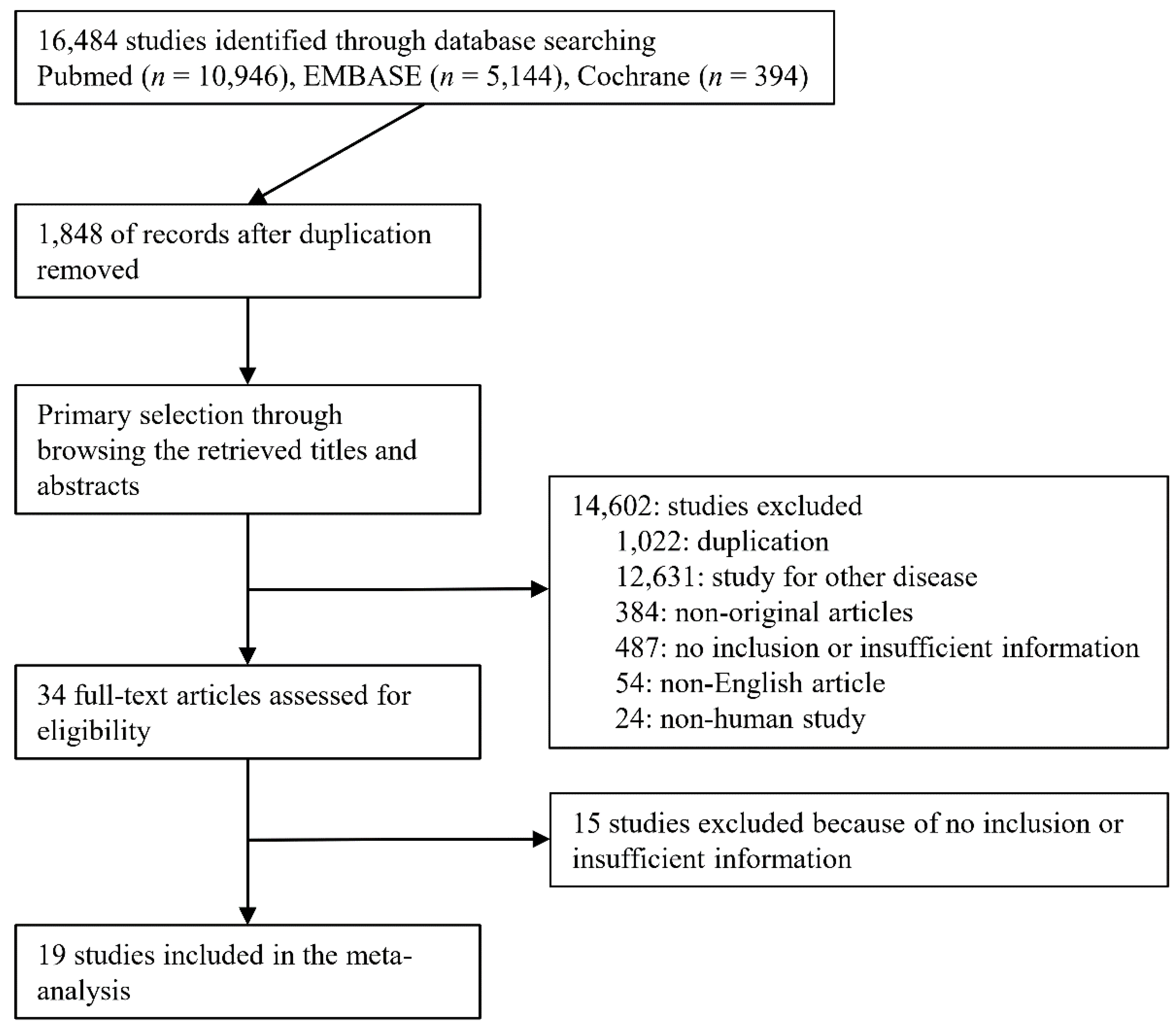
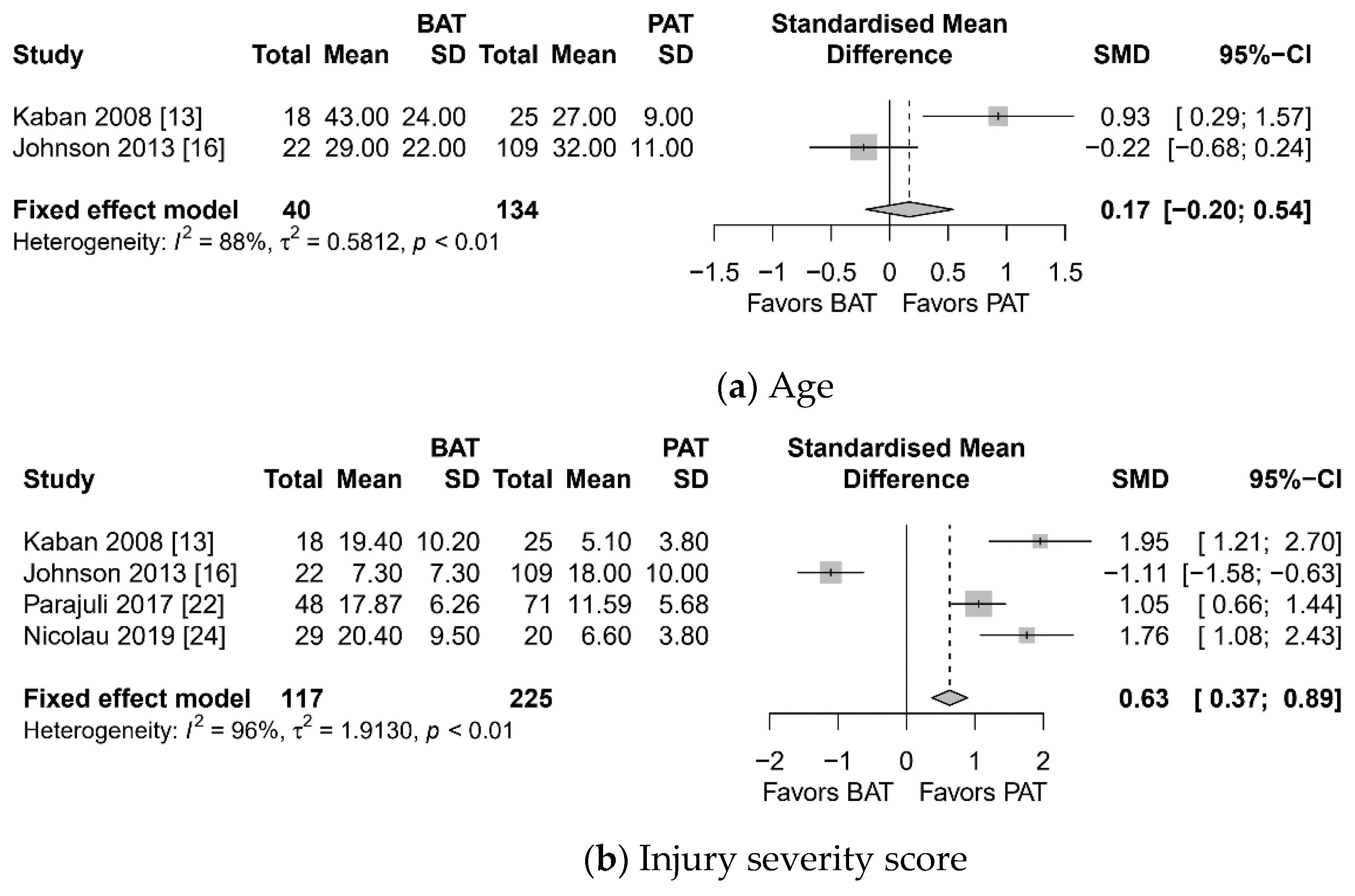
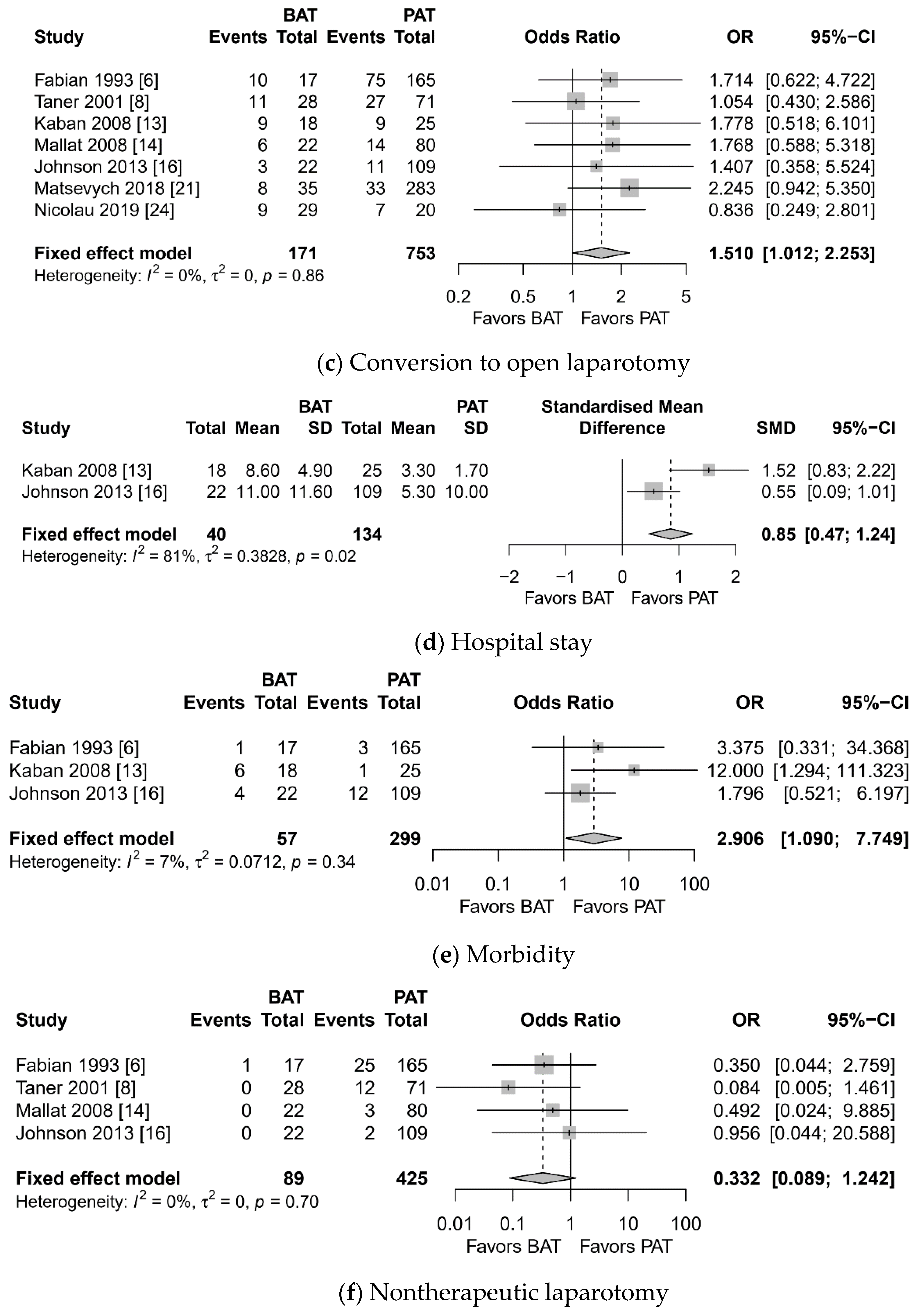

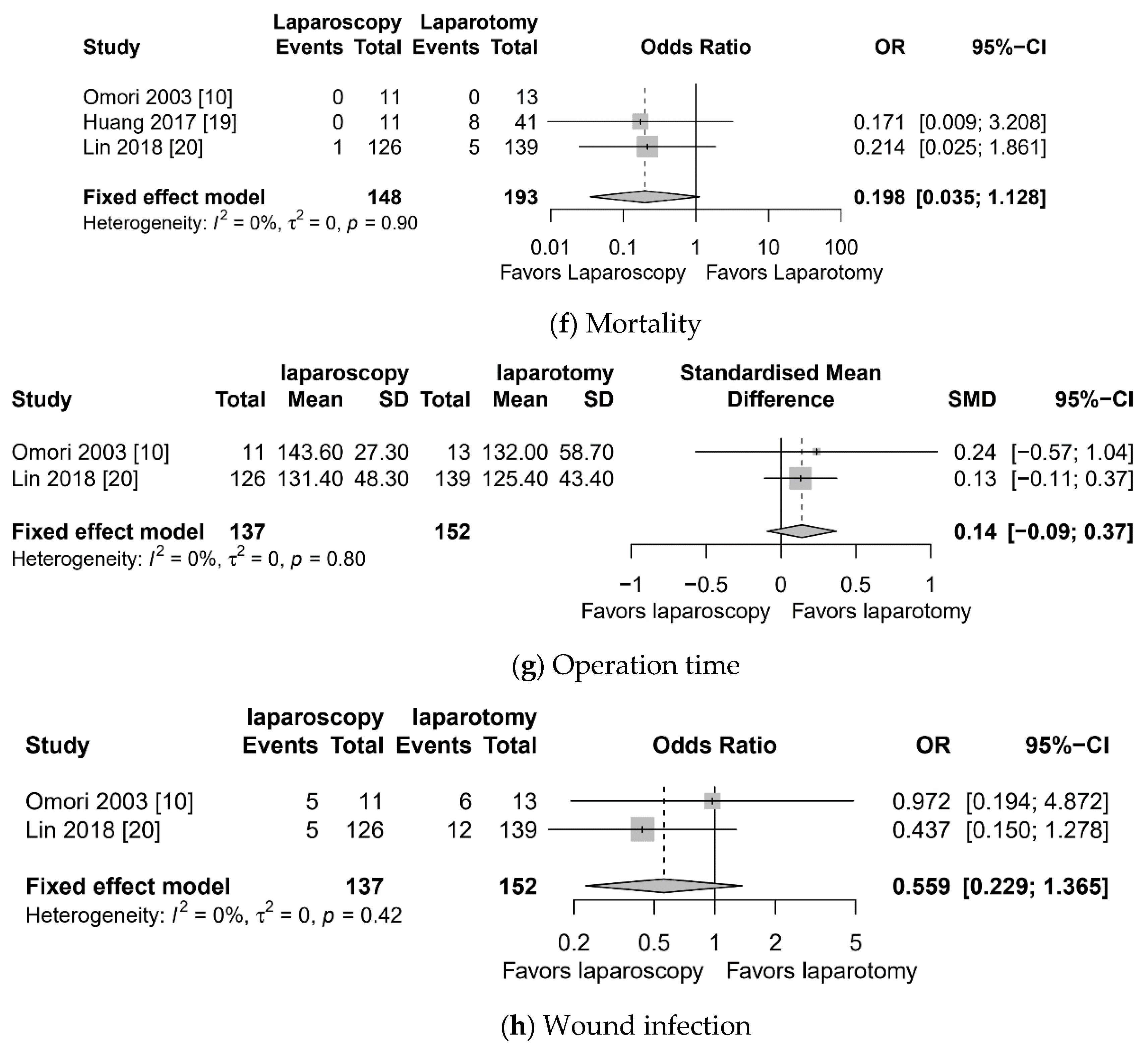
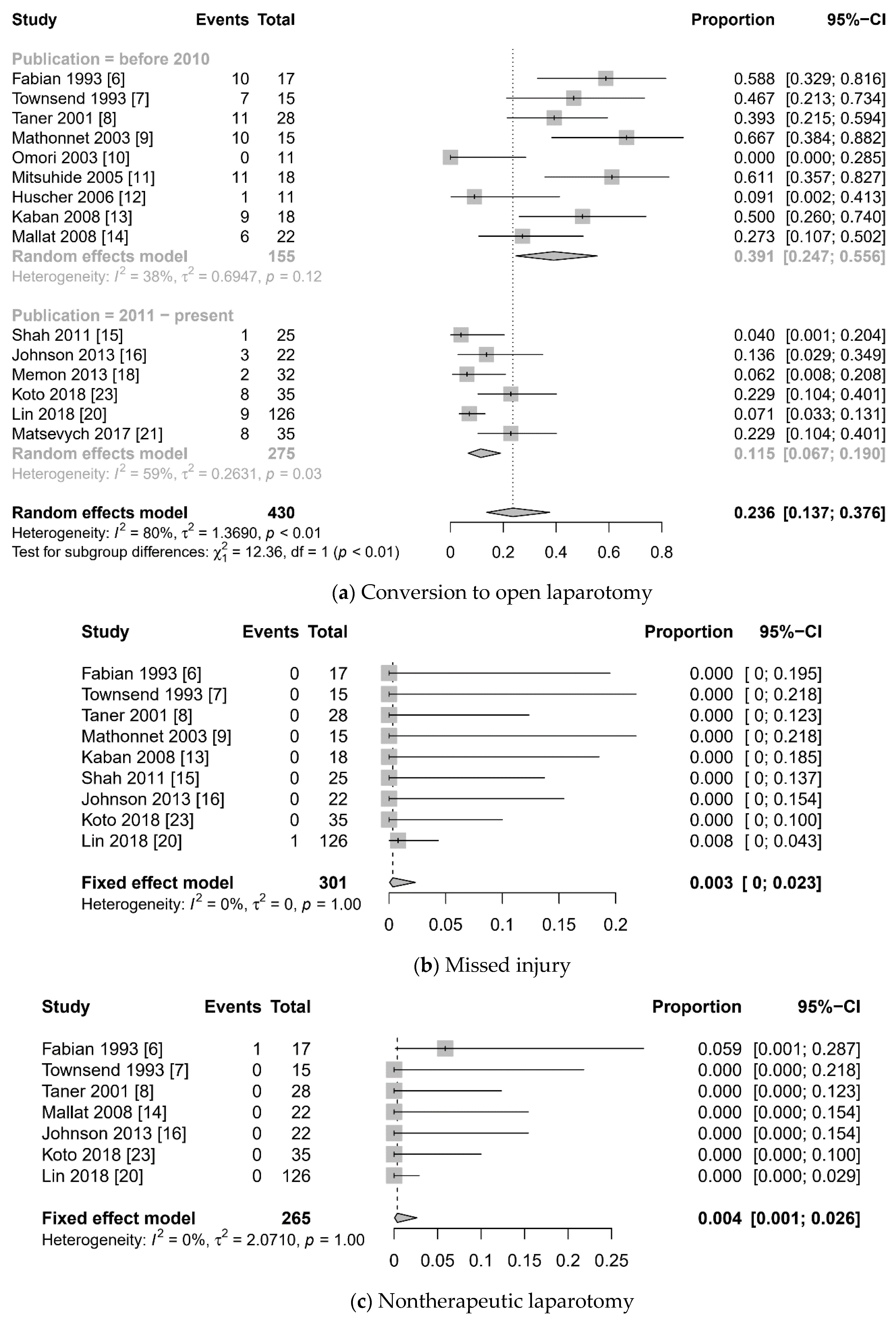
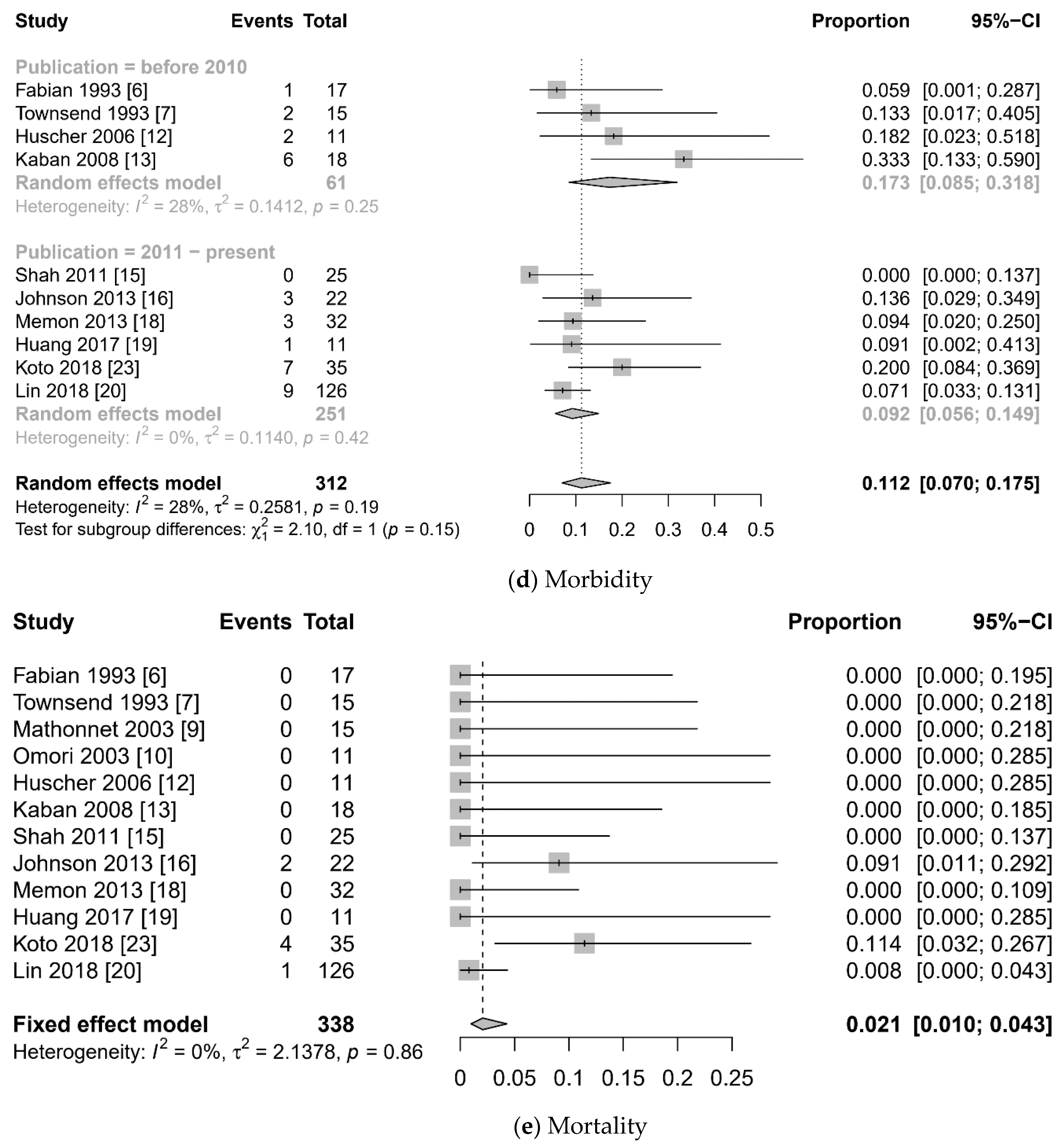
| Study | Country | Study Design | Study Period | Type of Trauma | Anatomic Location of Trauma | Comparison | Number of Participants | Hemodynamic Status | Exclusion Criteria of Laparoscopy | |
|---|---|---|---|---|---|---|---|---|---|---|
| Author | Year | |||||||||
| Fabian [6] | 1993 | United States | Observational, Single center | 1990–1991 | Blunt, penetrating | liver, spleen, stomach, small intestine, colon, mesentery, diaphragm, pancreas, duodenum, gall bladder, bladder, vascular | Blunt | 17 | Stable | Hemodynamic instability |
| Stab, Gunshot | 165 | |||||||||
| Townsend [7] | 1993 | United States | Observational, Single center | 1991–1992 | Blunt | liver, spleen | None | 15 | Stable | Hemodynamic instability, peritonitis, head injury, <18 years, pregnancy, previous abdominal surgery |
| Taner [8] | 2001 | Turkey | Observational, Single center | 1995–1999 | Blunt, penetrating | General abdominal trauma | Blunt | 28 | Stable | Hemodynamic instability, peritonitis, head injury, <18 years, pregnancy, previous abdominal surgery |
| Penetrating | 71 | |||||||||
| Mathonnet [9] | 2003 | France | Observational, Single center | 1985–2001 | Blunt | small intestine | None | 15 | Non-descriptive | Non-descriptive |
| Omori [10] | 2003 | Japan | Observational, Single center | 1993–1997 | Blunt | small intestine, colon | Laparoscopy | 13 | Stable | Hemodynamic instability |
| Laparotomy | 11 | Stable | ||||||||
| Mitsuhide [11] | 2005 | Japan | Observational, Single center | 1994–2002 | Blunt | stomach, small intestine, colon | None | 18 | Stable | Hemodynamic instability, massive hemoperitomeum, injuries to abdominal organ other than bowel |
| Huscher [12] | 2006 | Italy | Observational, Single center | 2000–2004 | Blunt | Spleen | None | 11 | Stable | Non-descriptive |
| Kaban [13] | 2008 | United States | Observational, Single center | 2001–2004 | Blunt, penetrating | General abdominal trauma | laparoscopy | 18 | Stable | Non-descriptive |
| laparotomy | 25 | |||||||||
| Mallat [14] | 2008 | United States | Observational, Single center | 1996–2006 | Blunt, penetrating | General abdominal trauma | Blunt | 22 | Stable | Non-descriptive |
| Stab, Gunshot | 80 | |||||||||
| Shah [15] | 2011 | India | Observational, Single center | 2004–2008 | Blunt | liver, spleen, stomach, small intestine, colon, kidney | None | 25 | Stable | Hemodynamic instability, severe head injury, sever chest injury, compound fracture, spine fracture, anticipated difficult endotracheal intubation, pregnancy |
| Johnson [16] | 2013 | United States | Observational, Single center | 2001–2010 | Blunt, penetrating | General abdominal trauma | Blunt | 22 | Stable | Non-descriptive |
| Penetrating | 109 | |||||||||
| Memon [18] | 2013 | Pakistan | Observational, Single center | 2010–2012 | Blunt | General abdominal trauma | None | 32 | Stable | Hemodynamic instability, severe internal bleeding, established peritonitis |
| Khubutiya [17] | 2013 | Russia | Observational, Single center | 2000–2011 | Blunt, penetrating | liver, spleen, stomach, small intestine, colon | Laparoscopy | 155 | stable | Hemodynamic instability, peritonitis, ongoing bleeding |
| Laparotomy | 106 | unstable | ||||||||
| Huang [19] | 2017 | United States | Observational, Single center | 2011–2014 | Blunt | spleen | Laparoscopy | 11 | stable | <18 years old |
| Laparotomy | 41 | stable | ||||||||
| Koto [23] | 2018 | South Africa | Observational, Single center | 2012–2015 | Blunt | Hollow viscus organ | Laparoscopy | 27 | stable | <12 years old |
| Converted to laparotomy | 8 | |||||||||
| Parajuli [22] | 2017 | India | Observational, Single center | 2008–2013 | Blunt, penetrating | liver, spleen, stomach, small intestine, colon, mesentery, diaphragm | Blunt | 48 | stable | Hemodynamic instability, evisceration, gunshot wound |
| Penetrating | 71 | stable | ||||||||
| Lin [20] | 2018 | Taiwan | Observational, Single center | 2006–2015 | Blunt | liver, spleen, stomach, small intestine, colon, mesentery, diaphragm, pancreas, duodenum, gall bladder, bladder | Laparoscopy | 126 | stable | Hemodynamic instability, FAST positive, attending surgeon’s decision |
| Laparotomy | 139 | stable | ||||||||
| Matsevych [21] | 2018 | South Africa | Observational, Single center | 2012–2015 | Blunt, penetrating | General abdominal trauma | Blunt | 8 | stable | Non-descriptive |
| Penetrating | 33 | stable | ||||||||
| Nicolau [24] | 2019 | Romania | Observational, Single center | 2006–2016 | Blunt, penetrating | liver, spleen, small intestine, colon, mesentery, diaphragm | Blunt | 30 | stable | Hemodynamic instability, <GCS 12; decompensated heart, lung or liver disease; major hemorrhage, organ evisceration, multiple major injuries, scarred abdomen |
| Penetrating | 20 | stable |
| Author | Year | Selection | Comparability | Exposure | Total Score | |||||
|---|---|---|---|---|---|---|---|---|---|---|
| Adequate Definition of Patient Cases | Representativeness of Patient Cases | Selection of Controls | Definition of Controls | Control for Important or Additional Factors | Ascertainment of Exposure | Same method of Ascertainment for Participants | Nonresponse Rate | |||
| Fabian [6] | 1993 | ⋆ | ⋆ | ⋆ | ⋆ | ⋆ | 5 | |||
| Townsend [7] | 1993 | ⋆ | ⋆ | ⋆ | ⋆ | ⋆ | 5 | |||
| Taner [8] | 2001 | ⋆ | ⋆ | ⋆ | ⋆ | ⋆ | ⋆ | ⋆ | 7 | |
| Mathonnet [9] | 2003 | ⋆ | ⋆ | ⋆ | ⋆ | ⋆ | 5 | |||
| Omori [10] | 2003 | ⋆ | ⋆ | ⋆ | ⋆ | ⋆ | ⋆ | ⋆ | 7 | |
| Mitsuhide [11] | 2005 | ⋆ | ⋆ | ⋆ | ⋆ | ⋆ | 5 | |||
| Huscher [12] | 2006 | ⋆ | ⋆ | ⋆ | ⋆ | ⋆ | 5 | |||
| Kaban [13] | 2008 | ⋆ | ⋆ | ⋆ | ⋆ | ⋆ | ⋆ | ⋆ | 7 | |
| Mallat [14] | 2008 | ⋆ | ⋆ | ⋆ | ⋆ | ⋆ | ⋆ | 6 | ||
| Shah [15] | 2011 | ⋆ | ⋆ | ⋆ | ⋆ | ⋆ | 5 | |||
| Johnson [16] | 2013 | ⋆ | ⋆ | ⋆ | ⋆ | ⋆ | ⋆ | ⋆ | 7 | |
| Memon [18] | 2013 | ⋆ | ⋆ | ⋆ | ⋆ | ⋆ | 5 | |||
| Khubutiya [17] | 2013 | ⋆ | ⋆ | ⋆ | ⋆ | ⋆ | ⋆ | 6 | ||
| Huang [19] | 2017 | ⋆ | ⋆ | ⋆ | ⋆ | ⋆ | ⋆ | ⋆ | 7 | |
| Koto [23] | 2018 | ⋆ | ⋆ | ⋆ | ⋆ | ⋆ | 5 | |||
| Parajuli [22] | 2017 | ⋆ | ⋆ | ⋆ | ⋆ | ⋆ | ⋆ | ⋆ | 7 | |
| Lin [20] | 2018 | ⋆ | ⋆ | ⋆ | ⋆ | ⋆ | ⋆ | ⋆ | 7 | |
| Matsevych [21] | 2018 | ⋆ | ⋆ | ⋆ | ⋆ | ⋆ | ⋆ | ⋆ | 7 | |
| Nicolau [24] | 2019 | ⋆ | ⋆ | ⋆ | ⋆ | ⋆ | ⋆ | ⋆ | 7 | |
| Variable | Moderator | Number of Studies (k) | Proportion | 95% CI | I2 | Test for Subgroup Differences (Random Effect Model) | |
|---|---|---|---|---|---|---|---|
| Conversion to Laparotomy | Publication Year of Study | Q | p-Value | ||||
| before 2010 | 9 | 0.391 | 0.246; 0.556 | 37.7% | 12.36 | <0.001 | |
| 2011–present | 6 | 0.115 | 0.067; 0.190 | 59.2% | |||
| Injured Organ | |||||||
| General abdominal organ | 9 | 0.202 | 0.105; 0.353 | 82.3% | 0.54 | 0.765 | |
| Solid organ | 2 | 0.265 | 0.073; 0.622 | 70.9% | |||
| Hollow viscus organ | 4 | 0.319 | 0.085; 0.703 | 72.3% | |||
| Morbidity | Publication year of study | ||||||
| before 2010 | 4 | 0.173 | 0.085; 0.318 | 27.5% | 2.10 | 0.147 | |
| 2011–present | 5 | 0.092 | 0.056; 0.149 | 0.0% | |||
| Injured Organ | |||||||
| General abdominal organ | 6 | 0.092 | 0.044; 0.181 | 51.5% | 2.43 | 0.297 | |
| Solid | 3 | 0.135 | 0.057; 0.286 | 0.0% | |||
| Hollow viscus organ | 1 | 0.200 | 0.099; 0.364 | ||||
| Mortality | Publication year of study | ||||||
| before 2010 | 6 | 0.000 | 0.000; 1.000 | 0.0% | 0.00 | 0.999 | |
| 2011–present | 6 | 0.019 | 0.004; 0.093 | 18.8% | |||
| Injured Organ | |||||||
| General abdominal organ | 6 | 0.009 | 0.001; 0.067 | 0.0% | 1.25 | 0.536 | |
| Solid organ | 3 | 0.000 | 0.000; 1.000 | 0.0% | |||
| Hollow viscus organ | 3 | 0.053 | 0.005; 0.383 | 0.0% | |||
Publisher’s Note: MDPI stays neutral with regard to jurisdictional claims in published maps and institutional affiliations. |
© 2021 by the authors. Licensee MDPI, Basel, Switzerland. This article is an open access article distributed under the terms and conditions of the Creative Commons Attribution (CC BY) license (https://creativecommons.org/licenses/by/4.0/).
Share and Cite
Ki, Y.-J.; Jo, Y.-G.; Park, Y.-C.; Kang, W.-S. The Efficacy and Safety of Laparoscopy for Blunt Abdominal Trauma: A Systematic Review and Meta-Analysis. J. Clin. Med. 2021, 10, 1853. https://doi.org/10.3390/jcm10091853
Ki Y-J, Jo Y-G, Park Y-C, Kang W-S. The Efficacy and Safety of Laparoscopy for Blunt Abdominal Trauma: A Systematic Review and Meta-Analysis. Journal of Clinical Medicine. 2021; 10(9):1853. https://doi.org/10.3390/jcm10091853
Chicago/Turabian StyleKi, Young-Jun, Young-Goun Jo, Yun-Chul Park, and Wu-Seong Kang. 2021. "The Efficacy and Safety of Laparoscopy for Blunt Abdominal Trauma: A Systematic Review and Meta-Analysis" Journal of Clinical Medicine 10, no. 9: 1853. https://doi.org/10.3390/jcm10091853
APA StyleKi, Y.-J., Jo, Y.-G., Park, Y.-C., & Kang, W.-S. (2021). The Efficacy and Safety of Laparoscopy for Blunt Abdominal Trauma: A Systematic Review and Meta-Analysis. Journal of Clinical Medicine, 10(9), 1853. https://doi.org/10.3390/jcm10091853






